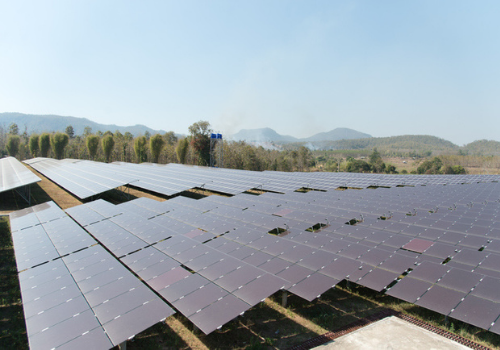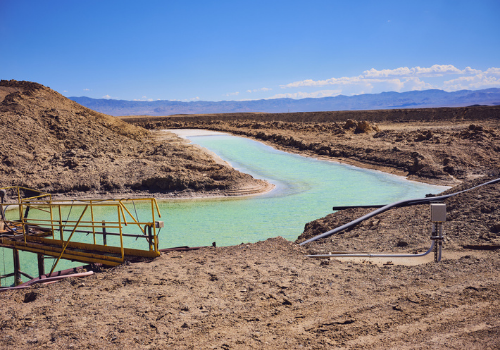As electric utility companies look to drastically reduce their CO2 emissions over the next several decades, significant steps are already being taken to begin modernizing the grid. Microgrids represent a key component of that modernization.
A microgrid is a localized energy grid. It can be disconnected from the primary grid and continue operating on its own when needed, such as when an outage occurs on the primary grid. This is referred to as “island mode.” A microgrid is also in a good position to leverage renewable energy sources, storing that energy in batteries until it is needed.
Many electric utility contractors have been working with microgrids for many years, particularly with respect to the leveraging of solar energy. Over the next several decades, however, the complexion of a microgrid is likely to change somewhat. As leading energy providers continue on their strategic paths toward net-zero carbon emissions, renewable energies and battery storage systems will become more commonplace.
“Over the next several years, utility contractors should develop an understanding of how to work with batteries,” says Dr. Zachary Kuznar, managing director of energy storage, microgrid and CHP development for Duke Energy, one of the largest electric power holding companies in the U.S. Duke Energy provides electricity to 7.7 million retail customers in North Carolina, South Carolina, Florida, Kentucky, Indiana and Ohio.
“Utility contractors should also develop an understanding of how to work with strictly inverter-based microgrids with no diesel genset as a backup,” Kuznar adds. “These microgrids are solar and battery only. Knowledge in that field is somewhat limited right now. Having the ability to understand the nuances and technology behind this type of microgrid, such as islanding, is important going forward.”
 Driving down emissions drives interest in microgrids
Driving down emissions drives interest in microgrids
Duke Energy aims to reduce CO2 emissions by 50% by 2030, and become net-zero by 2050.
“If you look at the current state of Duke Energy’s system, it has come a long way since around 2005,” Kuznar relates, adding that even though the company’s emissions-reduction goals may seem aggressive, they are completely achievable — even with technologies that already exist today.
“If you look at the diversity of energy generation for our regulated companies right now, it is about 37% natural gas, 21% coal, 35% nuclear and 7% ‘other’ which includes wind, solar, hydro and energy storage,” Kuznar points out. “To get to 2030 with current technologies, you’re talking about reducing coal to around 9%. Natural gas will increase to about 38%. Our nuclear projects will continue running and make up about 30%. Then you see a significant increase in wind, solar, hydro and storage, eventually making up about 23%.”
Another thing helping to fuel surging interest in renewables is cost.
“From a bird’s eye view, renewable energy generation is becoming very cost-effective, and economics really drive everything,” says Teague Egan, founder and CEO of EnergyX, a sustainable energy company focused on lithium extraction, separation, recovery and refinery technology, as well as solid-state battery storage.
“Energy storage is the key to all of this, though,” Egan continues. “Energy storage is needed to combat the intermittency of renewable energy generation. EnergyX is focused on making energy storage more affordable.”
To bring energy storage systems to market, a large supply chain is involved, from raw materials mining to battery manufacturing. From one end of that supply chain to the other, Egan says the focus must be on reducing the price per kilowatt-hour (kWh) of storage. A logical place to start is the key element of the most common battery storage system: lithium.
Where does the U.S. get lithium?
With more emphasis on electric vehicles (EVs) and equipment from manufacturers, demand for lithium is unprecedented.
“To put things into perspective, it takes 10,000 iPhone batteries to make up one car battery,” Egan says. “If you make 1 million EVs, that is 10 billion iPhones, which is roughly the total amount of smartphones ever manufactured. The thing is, roughly 2 million EVs were manufactured last year. So all of a sudden, we need a lot more lithium. That has left some people scrambling because there has never been significant lithium exploration done.”
Egan looks back roughly one century ago when oil was discovered in the Middle East. “It was almost like you could dig a hole with a shovel and oil would come pouring out,” Egan says. “Today, it’s a similar situation with lithium in South America. There is a location known as the Lithium Triangle spanning from northern Chile to northern Argentina and southern Bolivia. It’s due to the Andes mountain range.”
Egan is quick to point out that there are also plenty of lithium resources in the U.S. In fact, the U.S. contributes around 2% of global supply even though it holds roughly 17% of global reserves.
Wherever those lithium resources may be residing, the key is developing new extraction technologies to make lithium more economical to harvest.
 The price of lithium batteries
The price of lithium batteries
Some wonder what might happen to the price of lithium ion batteries as demand for lithium skyrockets. According to Egan, the lack of lithium exploration has been one problem. Another obstacle is the inefficient method of production which pushes lithium prices higher.
“Historically, there have been two lithium production methods,” Egan explains. “One is traditional hard rock mining. The second is extraction from a salt brine. Lithium is a salt found in extremely salty water alongside other salts. Producers recover those salts through natural evaporation. The problem is that they are only recovering about 30% of the available lithium. That is because lithium is so similar to other salts. It all comes out as a mix, and you can’t have a mix.”
Better lithium production methods will lead to more economies of scale, and that will lead to more cost efficiencies. As more R&D and resources are poured into lithium production, costs will be driven down.
This is the focus of companies like EnergyX. Their approach to lithium production is a mechanical separation process which moves material through a membrane filter. That filter only allows lithium to pass through. This allows producers to recover significantly more lithium because they don’t have to discard all of that lithium that is “contaminated” with other minerals.
“Through our unique extraction process, we are able to recover 90% of the available lithium in a fraction of the time,” Egan points out. It is very simple: Producing more in less time results in a lower cost of production. “We’ve basically created the equivalent of fracking for the lithium industry — without the environmental impact.”
Beyond lithium ion
While there is a pretty clear line of sight to 2030, Duke Energy’s Kuznar says 2050 is a different story. “That space between 2030 and 2050 is where we are really looking for emerging technologies to develop,” Kuznar says. That could be everything from burning hydrogen in turbines to longer-duration storage systems.
In the nearer-term, Duke Energy plans to invest in larger, megawatt-scale electrochemical batteries to modernize its electric system.
When you talk about electrochemical storage, Duke Energy’s main focus has been lithium ion, primarily because it is a mature battery technology with a well-established supply chain already in place.
“Lithium is great for that 1 to 4-hour duration,” Kuznar says. “That is why we’re really interested in some of these longer-duration technologies as we strive to reach the goals we’ve set beyond 2030.”
Longer storage durations aside, the diversification of raw materials used for energy storage is simply a wise approach to take. “Placing all of your eggs in one basket is never a good thing,” Kuznar says.
That is why Duke Energy has such a keen interest in several lithium alternatives. These include a range of thermal, mechanical and chemical technologies such as molten salt, compressed/liquified air, sub-surface pumped hydro, power to gas (i.e. hydrogen), and advanced battery chemistries.
“Currently, these alternative technologies are not at the scale of lithium where you have these gigafactories (Tesla) and other big companies with big balance sheets that are manufacturing them,” Kuznar points out.
Nonetheless, there is opportunity to further develop these alternative technologies over the next 30 years. One alternative Duke Energy has already been piloting is a zinc-based battery system from a company called Eos Energy Enterprises.
“This company is looking to fill the gap that exists with longer-duration storage,” Kuznar says. “Their sweet spot is anywhere from 3 to 10 hours of discharge. This almost starts to look like a pumped-hydro facility. The difference is that it is an electrochemical system we can deploy at different sizes and scales. The good thing is that this company is emerging from startup and really starting to scale its production of batteries that can be used on the bulk system.”
Another emerging technology that has caught Duke Energy’s eye is flow batteries. Kuznar says there are already some large, well-known companies including Honeywell that are already doing work in this space. “This technology will help solve the long-duration battery storage problem, so we’re very excited to eventually begin testing flow batteries,” Kuznar says.
Examples of current energy storage projects
Duke Energy has several energy storage projects under development throughout its six-state territory. One such project is the Hot Springs microgrid. Duke Energy added solar plus storage in a mountainous and wooded community in western North Carolina. That especially rugged environment made a long, traditional distribution line more susceptible to outages.
The Hot Springs project includes a 2-MW solar facility and 4-MW lithium-based storage facility. “We send solar to the grid and use battery storage for bulk system benefits,” Kuznar explains. “Also, if there is an outage on the primary grid, we’re able to island the microgrid system. A switch will open and the microgrid will basically continue to power the town for anywhere from 4 to 6 hours. Then it will automatically reconnect to the primary system when it is restored.”
Another Duke Energy project is in Florida. John Hopkins Middle School has a 3.5-MW solar plus storage microgrid. This system consists of a 1-MW solar parking canopy and a 2.5-MW battery system. This microgrid will enhance electric service, support grid operations, and provide backup electric power during outages when the school must convert to a hurricane evacuation shelter.
The Energy Transition
We’re only in the very early stages of the renewable energy transition. EnergyX’s Egan says battery technology will continue to improve. As more resources are invested in battery storage systems, batteries will continue to become smaller but last longer. “I think you’ll eventually see batteries that could power houses and entire communities for weeks and months on end,” Egan speculates.
When you think about goals like Duke Energy has set (carbon-neutral by 2050), Egan says massive economic and societal shifts will have to take place.
“It’s a slow transition, but think about how much can happen over the next 30 years,” Egan says. “Sometimes we underestimate ourselves. The way we live now, 30 years ago you would have thought we’re living in the Jetson’s age. We can accomplish incredible things when the focus is there from government and society.”
Join thousands of industry peers who receive utility construction industry news and trends each week. Subscribe to The Utility Expo Newsletter.
The Utility Expo is the largest event for utility professionals and construction contractors seeking comprehensive insights into the latest industry technologies, innovations and trends. The biennial trade show, known for equipment test drives and interactive product demonstrations, takes place in Louisville, Ky. The next event will be September 26-28, 2023.












